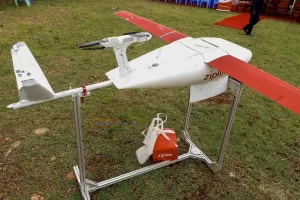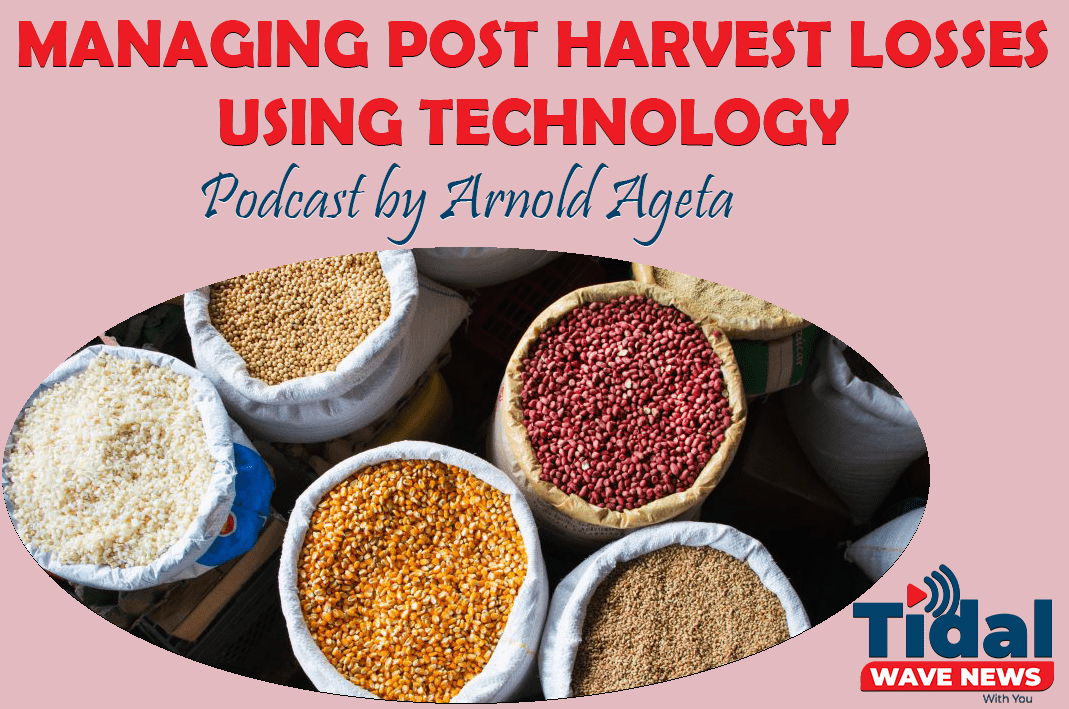
By Arnold Ageta
In Chepng’ombe village, a vibrant assembly of villagers, school children, health officials and guests has congregated to witness a momentous occasion-the inaugural drone delivery of vital medicines to the local health centres.
After a suspenseful 45 minutes, a striking white and red drone emerges, soaring into view from a distance.
The crowd suddenly breaks into jubilation as their eyes gaze to the skies following the path the drone takes.
The drone meanders through the sky before heading to the drop point. As the drone follows a straight line, the bottom of the drone opens displaying a red box containing drugs.
As it draws near the crowd, the red box is released and slowly drops with an improvised parachute that reduces the dropping impact.
The crowd gets excitedly loud as the first patch of drugs landed at Chepng’ombe health center.
The drones will help ease delivery of emergency health commodities in inaccessible health centers using road transport in a move to reduce maternal deaths in the county.
Statistics from the World Health Organization (WHO) indicate that maternal mortality is unacceptably high. About 287 000 women died during and following pregnancy and childbirth in 2020.
Almost 95 per cent of all maternal deaths occurred in low and lower middle-income countries in 2020, and most could have been prevented.
Sub-Saharan Africa and Southern Asia accounted for around 87 per cent 253000 of the estimated global maternal deaths in 2020.
Sub-Saharan Africa alone accounted for around 70 per cent of maternal deaths 202 000, while Southern Asia accounted for around 16 per cent 47 000.
The high number of maternal deaths in some areas of the world reflects inequalities in access to quality health services and highlights the gap between rich and poor.
To reduce maternal deaths in the county, Nyamira County has adopted drone technology to deliver emergency medical commodities to far flung health centres.

According to Nyamira County Health Chief Executive Health Member, Dr. Timothy Ombati, drone technology is the only way through which we can supply medical commodities to far flung areas, like Chepng’ombe.
‘‘That is why we made a choice of Chepng’ombe. Chepng’ombe is the furthest from Nyamira and of course, we have others towards this other direction,’’ he said.
Dr. Ombati cites challenges that the county sometimes faces like shortage of fuel during emergencies as another reason that forced them to adopt the drone technology.
‘‘Sometimes there are challenges to do with fuel and availability of the drivers. Lack of blood and emergency drugs during delivery can cause death because of bleeding,’’ he explained.
He says they have partnered with Zipline to provide drone delivery services in the county to help curb maternal deaths.
Winfrida Njeri, Zipline country director, has lauded the county for partnering with them as the county seeks to achieve universal health coverage.
‘‘This is a very bold move towards encouraging coverage of universal health to ensure that last mile delivery of medical products-emergency products is achieved. That people are not sent away from facilities because medicines are very far away, but can wait for a few minutes and the drone can deliver what they need,’’ said Njeri.
She emphasized their commitment to maternal health as their key mandate in providing drone services in the country.
‘‘Maternal health is actually our engine in Zipline. We are really keen on promoting maternal health especially to curb postpartum hemorrhage. When you start making blood available to facilities where they do delivery of mothers, it means also you are reducing postpartum hemorrhage and maternal deaths,’’ she emphasized.
Nyamira Governor Amos Nyaribo becomes the second governor in Kenya to adopt this technology after Kisumu.
The two governors bought the idea from Rwanda which has been using this technology for some time now.
‘‘We have seen this technology work in Rwanda and it has been used for some time now. The drone technology we have adopted only takes up to 45 minutes from Chemelil to deliver to Nyamira to save lives of expectant mothers,’’ said Nyaribo.
The drone technology will not be affected by weather changes. Ms Njeri said the drone is an all-weather service that will make sure delivery is not affected in any way.
‘‘The good thing about our technology and one of the key advantages is that we fly on all weather. We fly in rain, sun and snow. We’re able to fly on all weather and 24 hours for that matter. So we can also fly at night,’’ she argued.
According to her, the drone can carry up to 3 kilograms and they cover a radius of 100 kilometers from Chemelil with an ability to serve Nyanza and western Kenya counties.
Residents have welcomed the drone technology saying it will ease medicine delivery to health centres besides creating jobs for the youth.
‘‘Drone technology will give jobs to Nyamira people. It will be efficient and it will ensure that the drugs in Nyamira are safe and reach hospital in time,’’ said Kinara Shadrack one of the youths who attended the inauguration.




One thought on “Drone technology saving lives in rural areas”